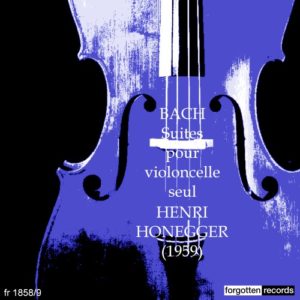
Henri Honneger. Bach Cello Suites. CD Forgotten Records fr 1858/9. Originally released 1961 on Valois records MB422/4 MX43/48 .
Recorded 10&11th February 1959 Copenhagen venue not stated.
No information relating to cello used found.
Introduction.
Originally a release in limited numbers on vinyl only, this recording by the relatively obscure Swiss cellist is sought after by collectors. The 3LP box sets are now fetching large amounts of money. Fortunately for those of us who are more impecunious there is a release on CD by the French specialist record label Forgotten Records. This label specialises in high quality recordings taken from vinyl. If you enjoy exploring the obscure, then their catalogue is worth a look.
https://forgottenrecords.com/en
There are many reissues on Lp by Valois and Telefunken. Also CD on Analog Collector 2014.
The cellist.
There is remarkably little to find about Henri Honegger on the internet. There is more information available about his compatriot and composer Albert Honegger (no relation).
The best I can find comes from a publication from the mid 50s by a group of Swiss ex pats in the UK.
https://www.e-periodica.ch/cntmng?pid=swo-001:1955:0::732
From this document we learn that Feuermann was one of Honegger’s teachers and that it would appear that Honegger toured the Bach cello Suites quite extensively in the immediate post war period.
The Recording.
I have to say the quality of sound from the CD reviewed is surprisingly good. The re-mastering process edits out the majority of the vinyl extras that one expects from even the best quality records. What remains however is a distinct rumble from what I assume is the original tape recording. I am very sure it is not from the transcription turntable! The noise is not distracting but reminds the listener of the age of the recording. The re-mastering process preserves the clarity, dynamics and frequency range of the cello. The enjoyment of this performance is not limited by sound issues. Needless to say it is a mono reproduction, but with a good width soundstage.
The music.
Honegger’s performance suffers comparison with contemporary recordings by Fournier, Starker and Tortelier. It is found wanting in the technical prowess stakes. This is I suspect due to a limited recording schedule. Two days is unlikely to be long enough to achieve flawless recordings no matter how good the cellist. However, in the musical stakes I would suggest it bears comparison.
In style, the playing is typical of the 50s,60s and 70s in that there is a full bodied cello sound, with plenty of dynamics. There is not a lot of variation in the timing, just enough to enhance the phrasing. Vibrato is used sparingly, but not noticeably, I suspect due to a very fast and narrow technique. This is particularly effective in the fifth Sarabande. This movement is, I feel is a highlight, where vibrato appears absent entirely. There is plenty of legato playing with many passages of slurred notes. The second Courante stands out for me as having separately bowed notes but played smoothly as opposed to articulated and separated.
Speeds are very conventional with few movements raising the eyebrows. As an exception to this, again in the fifth Suite, the Courante sounds very sedate. This does in fact complement the general foreboding and gloominess portrayed so well by the preceding Prelude and Allemande.
Comparisons.
Some of the other contemporary recordings of this time such as by Annlies Schmidt stand out due to what I would call quirks of style. Schmidt plays very fast indeed. Mainardi tends to vary speeds significantly and emphasise key notes rather dramatically. Honegger seems to lapse into quirkiness only occasionally. However, they do stand out. An example of this is the tendency to “swell” on key notes in the first Courante. Honegger lands on the note in the normal way but then emphasises it with a crescendo. This does not seem to have been repeated obviously elsewhere. Another example in the third Suite first Bourrée; the F sharp before the repeat is given very prominent and unexpected prominence. This may sound like nit-picking but these issues cause me sit up and take notice for the wrong reasons!
Overall, the style of playing is to use long legato phrases in slower movements including Preludes. In most of the Courantes Gigues and dance movements Honegger plays in a lively up beat manner with good articulation. The previously noted technical deficiencies are particularly noticed in the sixth Suite Courante and Gigue.
A highlight for me is the lovely smooth flowing interpretation of the first Prelude. The bow control to provide evenness of the cross string passages impresses. Unfortunately, the sixth Prelude does not display this facility with distinctly uneven triplets in the introductory bars.
Another highlight is the mood projected by the second Suite performance which is very ethereal and slightly sinister! Honegger was undoubtably a very musical and sincere interpreter of Bach with no evidence of showmanship.
Conclusion.
To summarise, I would suggest that whilst this is a flawed performance it is worth investigating if you are keen on early recordings from this era. I suspect Honegger’s style of playing is more suited to romantic writing.
Charles.